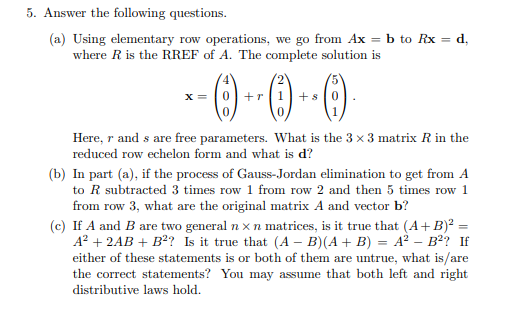5. Answer the following questions. (a) Using elementary row operations, we go from Ax = b to Rx = d, where R is the RREF of A. The complete solution is x = |0+r +s Here, r and s are free parameters. What is the 3 x 3 matrix R in the reduced row echelon form and what is d? (b) In part (a), if the process of Gauss-Jordan elimination to get from A to R subtracted 3 times row 1 from row 2 and then 5 times row 1 from row 3, what are the original matrix A and vector b?
5. Answer the following questions. (a) Using elementary row operations, we go from Ax = b to Rx = d, where R is the RREF of A. The complete solution is x = |0+r +s Here, r and s are free parameters. What is the 3 x 3 matrix R in the reduced row echelon form and what is d? (b) In part (a), if the process of Gauss-Jordan elimination to get from A to R subtracted 3 times row 1 from row 2 and then 5 times row 1 from row 3, what are the original matrix A and vector b?
Linear Algebra: A Modern Introduction
4th Edition
ISBN:9781285463247
Author:David Poole
Publisher:David Poole
Chapter2: Systems Of Linear Equations
Section2.2: Direct Methods For Solving Linear Systems
Problem 3BEXP
Related questions
Question

Transcribed Image Text:5. Answer the following questions.
(a) Using elementary row operations, we go from Ax = b to Rx = d,
where R is the RREF of A. The complete solution is
X =
+r|1+s
Here, r and s are free parameters. What is the 3 x 3 matrix R in the
reduced row echelon form and what is d?
(b) In part (a), if the process of Gauss-Jordan elimination to get from A
to R subtracted 3 times row 1 from row 2 and then 5 times row 1
from row 3, what are the original matrix A and vector b?
(c) If A and B are two general n x n matrices, is it true that (A+ B)? =
A? + 2AB + B? Is it true that (A – B)(A + B) = A² – B²? If
either of these statements is or both of them are untrue, what is/are
the correct statements? You may assume that both left and right
distributive laws hold.
Expert Solution
This question has been solved!
Explore an expertly crafted, step-by-step solution for a thorough understanding of key concepts.
Step by step
Solved in 3 steps

Knowledge Booster
Learn more about
Need a deep-dive on the concept behind this application? Look no further. Learn more about this topic, advanced-math and related others by exploring similar questions and additional content below.Recommended textbooks for you

Linear Algebra: A Modern Introduction
Algebra
ISBN:
9781285463247
Author:
David Poole
Publisher:
Cengage Learning

Algebra & Trigonometry with Analytic Geometry
Algebra
ISBN:
9781133382119
Author:
Swokowski
Publisher:
Cengage

Linear Algebra: A Modern Introduction
Algebra
ISBN:
9781285463247
Author:
David Poole
Publisher:
Cengage Learning

Algebra & Trigonometry with Analytic Geometry
Algebra
ISBN:
9781133382119
Author:
Swokowski
Publisher:
Cengage